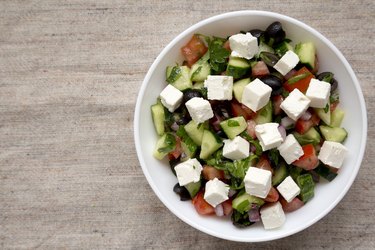
An online calorie calculator that estimates your needs is helpful, but it's not always obvious how to implement the results. A 1,900-calorie meal plan may seem too specific to fit into most nutritional guidelines. Yet it's not hard to modify a basic healthy-eating diet to meet your calorie goal.
Read more: Exactly What to Eat on the Mayo Clinic Diet
Video of the Day
Video of the Day
Why 1,900 Calories?
Adult women need anywhere between 1,600 and 2,400 calories each day to maintain their weight, according to the U.S. Department of Health and Human Services' 2015-2020 Dietary Guidelines for Americans. A somewhat-active woman in her 30s, for example, needs about 2,000 calories for optimum health, if she doesn't need to gain or lose weight.
But sometimes your own dietary needs aren't quite "one size fits all." For example, you might have reached your ideal weight, and additionally have an active lifestyle that requires more than a restricted-calorie diet. Yet your petite frame might gradually gain unwanted weight on the typical 2,000 calorie meal plan.
Adding more personal information into an online calorie calculator such as that provided by Mayo Clinic may indicate that a more specific number, such as 1,900 calories, is a better number to strive for, based on the person's exact weight, height and activity level. It might also be the best amount to aim for if a person wishes to gain or lose weight.
Charting Your Course
Many healthy diet plans are based on a 2,000 calorie diet. When you need to be strict about 1,900 calories, eliminating a snack, or choosing one of the lower-calorie options within a food group can help you achieve that 1,900-calorie meal plan.
It's helpful to use a calorie-tracking tool to keep your total amounts as close to 1,900 calories per day as possible. If real-world factors make it hard to stay at or below that figure, eating a bit less the following day can help keep you on target.
The sample meal plan below is about 1,900 calories, according to tabulated estimates from the U.S. Department of Agriculture. It falls within the range of servings-per-food-group suggested by institutions such as the American Heart Association.
Keep in mind that one dish does not always equal just one serving. A generous portion of hot cereal might equal two grain servings, for example, while a big bowl of salad can provide at least two vegetable servings.
Read more: How to Build a 7-Day Healthy Meal Plan on a Budget
Breakfast (537 Calories)
A hearty breakfast starts with a 1-cup serving of oatmeal that's topped with a cup of sliced bananas and 1 ounce of walnuts. It can be enjoyed with an 8-ounce glass of vegetable juice and a cup of coffee.
- Oatmeal (166 calories)
- Sliced bananas (134 calories)
- Walnuts (186 calories)
- Vegetable juice (50 calories)
- Coffee (2 calories)
Morning Snack (194 Calories)
A light morning snack of five whole-wheat crackers, topped with 1 tablespoon of peanut butter, can be just what you need to keep you going until lunch. The crackers provide fiber, while the protein in the peanut butter boosts energy.
- Whole-wheat crackers (100 calories)
- Peanut butter (94 calories)
Lunch (441 Calories)
A salad with fresh greens, vegetables and toppings like cheese and turkey breast provides a range of nutrients. If you're eating out, select a chef's or Cobb salad, but ask them to withhold some of the fattier options, such as bacon and heavy dressing. Pair a 2-cup serving of this salad with a whole-wheat roll or piece of bread. Finish with a single-size container of nonfat Greek yogurt and 1/2 cup of blueberries.
- Cobb salad (208 calories)
- Light Italian dressing (14 calories)
- Nonfat Greek yogurt (100 calories)
- Blueberries (42 calories)
- Whole-grain bread or roll (76 calories)
- Water with lemon wedge (1 calorie)
Afternoon Snack (42 calories)
A miniature box of raisins is portable enough to keep tucked in your desk or purse. Going for the smaller raisin box not only controls calories, but keeps you from getting a sugar rush. This size provides about ½ serving of fruit.
- Raisins (42 calories)
Dinner (687 Calories)
A medium fillet of cod isn't high in calories, but does provide extra protein. (If you've consumed more calories than you planned earlier in the day, you can opt for a smaller, 3- to 4-ounce fillet and save about 100 calories.) Pair it with 1 cup of brown rice, 1 cup of cooked broccoli and a glass of skim milk. Need to indulge your sweet tooth? A dessert featuring a 1-cup serving of pineapple chunks with a dollop of whipped cream may hit the spot.
- Cod, medium fillet (200 calories)
- Brown rice (248 calories)
- Cooked broccoli (55 calories)
- Skim milk (83 calories)
- Pineapple chunks (83 calories)
- Whipped cream, 2 tablespoons (16 calories)
- U.S. Department of Health and Human Services: "2015-2020 Dietary Guidelines for Americans"
- Mayo Clinic: "Calorie Calculator"
- American Heart Association: "Suggested Servings From Each Food Group"
- USDA: "Nutrition Facts for Cooked Oatmeal"
- USDA: "Nutrition Facts for Walnuts"
- USDA: "Nutrition Facts for Campbells V8 100% Vegetable Juice"
- USDA: Nutrition Facts for Crackers, Whole-Wheat"
- USDA: "Nutrition Facts for Peanut Butter (Smooth)"
- USDA: "Cobb Salad, No Dressing"
- USDA: "Nutrition Facts for Salad Dressing Italian Dressing Fat-Free"
- USDA: "Nutrition Facts for Nonfat Greek Yogurt"
- USDA: "Nutrition Facts for Blueberries"
- USDA: "Food Lists"
- USDA: "Nutrition Facts for Rolls, Dinner, Wheat"
- USDA: "Nutrition Facts for Lemon Juice, Raw"
- USDA: "Nutrition Facts for Raisins"
- USDA: "Nutrition Facts for Cooked Cod"
- USDA: "Nutrition Facts for Brown Rice"
- USDA: "Nutrition Facts for Broccoli (Cooked)"
- USDA: "Nutrition Facts for Skim Milk"
- USDA: "Nutrition Facts for Pineapple"
- USDA: "Nutrition Facts for Whipped Cream"
- USDA: "Nutrition Facts for Coffee"
- USDA: "Nutrition Facts for Bananas"